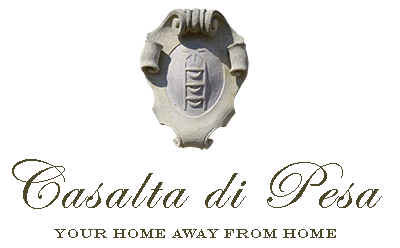Once upon a time
History and origins of the hamlet
of Casalta di Pesa.

The hamlet of Casalta di Pesa
The property of “Casalta di Pesa” is situated in the Casalta di Pesa area in the province of Castellina in the very heart of Chianti, on the border between the provinces of Siena and Florence. Small, rural settlements like this have been present in the area from the time of Roman-Etruscan civilisation. These villages are situated in the small valleys formed by the innumerable streams which merge into the major rivers of the region, the Pesa, the Greve and the Arbia.
The fertility of the land between Siena and Florence has always provided hugely favourable conditions for farming and agriculture. The soft, rolling hills, averaging an altitude of around 1300 feet, have allowed the development of the perfect rustic environment in which agriculture, nature and culture co-exist in perfect harmony, coming together to create landscape which is both subtle and evocative.

Castellina in chianti
The existence of small villages dating from ancient times, is well-documented. Etruscan burial mounds and the general lay of the land are clearly of Latin origin, and are important indicators of the existence of human settlements from Roman times, if not before.
Here in the province of Castellina, on the western slope of the high Pesa valley, exactly midway between Florence and Siena, two adjoining villages grew up in ancient times, both of them taking the name Grignano (from the Latin name of an owner from many centuries before called “Agrinius”).
At the same time that these two villages were developing, there is well-documented evidence, dating from the thirteenth century, of the presence of two parochial churches, belonging to the parish of San Leolino and Panzano. The first church, Santa Maria at Grignano still exists. The second, Sant’Andrea at Grignano, was built where the tiny hamlet of Ponte del Molin Nuovo exists today. In the late middle-ages, with the spread of farming in the area, a number of small, isolated communities sprung up all through the area. One of the first was Grignanello, close to which the rural settlement of Casalta di Pesa is to be be found.
In many cases, the beauty, wealth and fertility of these areas has represented not only a blessing, but also a historical curse – constant confrontation between Tuscan cities to assure their own control of the regions, existed for many centuries. Dante’s “Divine Comedy” tells of the ancient hatreds and blood wars between different Tuscan factions fought in this area – one only has to consider two of the most well-known characters involved, Farinata Degli Uberti and the Conte Ugolino, Hell, Canto X, whose struggle is described as, “The torment and the great massacre” which “made the Arbia colored red”.
Galileo Galilei spent some time here...
Between the end of the sixteenth century and the beginning of the seventeenth, the transformation of agricultural methods brought intense construction and semi-urbanisation activity to the area, with the first stone farmhouses, as well as an increasing production of wine, oil and grain of unique and unparalleled quality. It was in this period that the fortified village of Casalta di Pesa came into being, and with a specific purpose in mind. The continuous raids and challenges to local dominance on the part of the cities of Siena and Florence, who continued to struggle for control of the fertile territories of the Chianti region, which lay between the two cities, meant that local rulers had to defend themselves against regular incursions into their territory. The local populace was obliged to construct strong defences around the village to keep attacks at bay. The character of the building fortifications in the north and south of the area, as well as the brick kiln, still to be seen today, give a good indication of the age of the original settlement, as they date from around 1600.
Census and population archives from Sant’Andrea of Grignano, now located at the State archive in Florence, suggest that from 1585 until 1778, Grignanello and Casalta di Pesa were owned by the Florentine Galilei family. The coat of arms of the family of the founder of modern scientific method can be seen in part of the original buildings in this area. It is highly likely that Galileo Galilei spent some time here, together with his beloved daughter Virginia, in a long period of rest and recuperation following a period of torture and house arrest imposed by the Inquisition.
The first written evidence of a rural settlement in the Casalta di Pesa comes from 1825 when the first Tuscan land registry was drawn up. The hamlet is shown on maps and is a typical example of the farming communities springing up in the area at the time. The development of village life was the result of the increasing need to provide houses for the peasant families who came to the area. The presence of buildings, both for domestic use, storage and productive activity, dating from the sixteenth and early seventeenth centuries, clearly indicates that agricultural workers had begun to put down roots in the area in the previous century or thereabouts.
An example of this activity is the barn that is located downstream of the main village workshop, which still maintains the form and features of the original. However, this construction, depicted in the nineteenth century land registry took the place of the original barn. The foundations of the original, which are still visible, were used to build a swimming pool area overlooking a magnificent landscape, with the hamlet of Panzano towards the north east. From here one can see the entire territory of the Gallo Nero, one of the most beautiful and evocative panoramas in the land.



